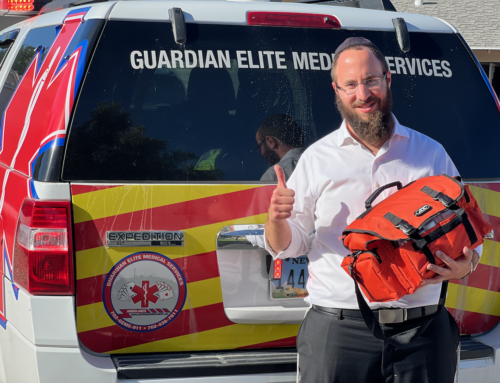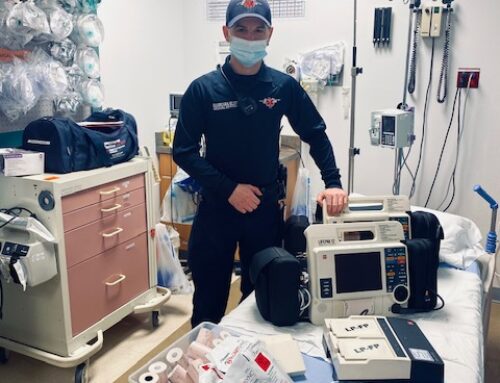On the one year anniversary of the October 1 shooting I would like to take a moment and reflect on this day as not many people know that Guardian Elite Medical Services was involved in the October 1, 2017 response. In addition, there are some lessons that we took away as a company to ensure that we are prepared to handle another incident if it should ever occur.
Guardian Elite Medical Services had just finished Life Is Beautiful one week before. I had broken my left hand at Life Is Beautiful and was in a cast. My father was flying home and was scheduled to land at 2200 so I went to go pick him up. Normally I am in my company issued Ford Explorer that has radios so I can monitor what is happening around me, however with my hand being in a cast I took his car so he could drive back from the airport.
It was around 2215 and I was getting off the I-15 at Tropicana. Because my hand was in a cast and I was driving I could not figure out my father’s AM/FM radio so I did not bother changing the channel. As I got off on Tropicana I saw some ambulances and police cars heading towards the scene of the incident. I did not know initially what was happening. At first I thought I saw a bus accident as there was a partially obstructed bus and that is where the emergency vehicles were driving to. As I pulled up to Tropicana and Las Vegas Blvd, I was forced to make a U-Turn by the Nevada Taxicab Authority. I did not think much of anything because to me it looked like some kind of bus incident ahead. What I did think was weird, was the Nevada Taxicab Authority directing traffic.
I made the U-Turn and got on the freeway again and got off at Flamingo. As I was getting off I saw NHP shutting down the freeway exit right when I got off. I continued down Flamingo to Paradise unaware of what was happening. I was at Paradise between Harmon and Tropicana when I saw a MedicWest Ambulance driving with their siren, but no emergency lights. I called MedicWest Dispatch to advise of their ambulance being in a potentially dangerous situation. This is the response I got from the dispatcher, “We are working an active shooter situation. I don’t have time for this. Click.”
My first reaction was that she hung up on me and how dare she! Then it hit me what she said. In addition, I saw crowds of people walking at Tropicana and Paradise, which I thought was weird. I immediately got on my cell phone to my Operations Manager. He was providing medical coverage to a movie set at the time. I told him what I was told and asked him to do some research. 2 minutes later he called me advising what he knew, which was that there was an active shooter situation on the Las Vegas Strip. He told me that he was leaving his production to go to the office and continue to monitor the situation. I continued to the airport to pick up my father. When he got in the car I had him drive so I could continue to monitor the situation with the limited information I had.
As more reports were coming in and the story was hitting local news my Operations Manager called me to ask if we should go. We had not yet received any formal activation from Clark County to send our resources. My Operations Manager called the Fire Alarm Office and advised of our available resources and they asked us to respond. The official message was sent out for our staff to head to the office for an active shooter situation with unknown details.
10 of our employees responded to station within 30 minutes. My Operations Manager loaded up all 4 of our ambulances and our MCI Trailer and headed towards where we were told to stage. Our designated staging location was Flamingo and Paradise. That’s where I met up with the crew after dropping my father off and picking up my company issued Ford Explorer. We monitored radio communications from AMR, MedicWest, and LVMPD. After about 45 minutes at Flamingo and Paradise we relocated our resources to CCFD Station 18 where AMR was staging their resources.
We made contact with the AMR Operations Supervisor, Matt. We advised on our resources available and continued to stage with AMR. We made available to AMR our MCI trailer so they had a place to work out of and went and got waters for AMR crews. We split our resources and sent a team over to the staging location at Las Vegas Blvd and Russell to hand out waters to crews. We continued to stage with AMR until it was deemed that we were no longer needed and then we headed home.
Although we did not provide patient care and had a supporting role in the response efforts, for us as a company it was a huge deal that we were asked to respond to Las Vegas’s largest incident. We did take away a few lessons from that night:
- First of all, the shooting that night could have happened at any of our events. In the weeks after the shooting we learned that the shooter was at the Life Is Beautiful festival the prior week and this could have easily been my staff that would have been in the line of fire.
- Proper planning is key! Not only for special events but for emergency call outs within our organization. That night the cellular networks were overloaded, which made communicating to our staff they were needed for an emergency response. Many of our staff members would have responded if they had received the emergency notifications.
- Our equipment is available 24 hours a day 7 days a week. This means that at any time, any agency can request our resources for any incident. On the night of October 1, 2017, our resources were heading to the staging area within 45 minutes of activation. Remember, all personnel were coming from home.
In the year since the October 1 incident we have changed our organization significantly, including:
- 24 hour operations – at the time of the event all staff had to come from home. Now with our ambulance franchise in the City of Las Vegas we maintain 24 hour ambulance operations to respond to incidents if needed.
- Better equipment – although our MCI trailer was adequately staffed that night we have better prepared our trailer. This includes the addition of tourniquets and bleeding control supplies.
- Better training – we have been training our staff and the general public in the use of AEDs, First Aid, and tourniquet use. In addition, many of our staff have become Stop the Bleed or CPR/First Aid instructor.
- Better communications – over the last year we have invested in 800mhz SNACC radios to communicate with local responders, purchased a mobile radio repeater that has been deployed into our MCI trailer, and contracted with a company that can provide mass communications to our staff during a large incident.
- Better planning – although we worked closely with all public agencies prior to October 1, 2017, in the last year we have worked even closer with them to ensure smooth operations at special events.



